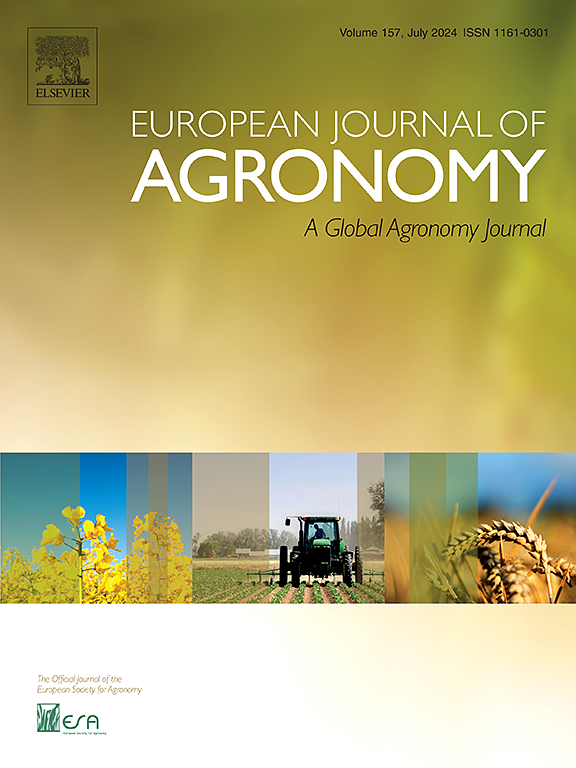减氮与生物炭相结合对提高玉米产量和氮利用率的可持续影响
IF 4.5
1区 农林科学
Q1 AGRONOMY
引用次数: 0
摘要
长期使用化肥对实现最佳作物产量的可持续性提出了挑战,甚至可能降低产量和化肥使用效率。可持续的环保农业实践必须通过减少化肥施用量来应对这些挑战。生物炭是一种前景广阔的解决方案,在提高土壤肥力和作物产量方面潜力巨大。然而,在减少氮肥施用量的情况下,生物炭在维持或提高作物产量方面的功效仍不明确。这项为期三年(2019-2021 年)的夏季玉米田间研究旨在阐明在不同的氮肥施用制度下,施用生物炭对作物产量、土壤特性和经济效益的影响。研究评估了四种生物炭施用量(0、8、16 和 24 吨/公顷-1)以及三种氮肥施用量:常规氮肥施用量(200 千克/公顷-1)、减少 20% 氮肥施用量(160 千克/公顷-1)和减少 40% 氮肥施用量(120 千克/公顷-1)。生物炭在试验开始时施用一次,而氮肥则每年施用一次。对三年数据的综合分析表明,即使在减少氮肥施用量的情况下,生物炭也能持续改善玉米的生长、氮吸收、谷物产量和经济收益。虽然第一年生物炭对玉米产量的影响不明显,但第二年比第三年的影响更明显。路径分析强调了土壤有机碳(SOC)、全氮含量和阳离子交换容量的增加在提高玉米产量及其组成部分方面的关键作用。此外,减少 40% 的氮肥与 16 吨/公顷生物炭的组合在 2020 年和 2021 年保持了较高的玉米产量,表明生物炭的比例适合在 2-3 年内持续发挥功效。从 2019 年到 2021 年,添加生物炭后玉米籽粒产量平均增加了 8.5-18.4%,而 2020 年和 2021 年的经济效益增加了 15.1-18.4%。这些研究结果凸显了生物炭对作物生产力至少三年的持久影响,表明生物炭具有持续提高玉米产量和净收入的潜力,同时促进了可持续农业实践。本文章由计算机程序翻译,如有差异,请以英文原文为准。
Sustainable effects of nitrogen reduction combined with biochar on enhancing maize productivity and nitrogen utilization
Long-term chemical fertilizer use poses sustainability challenges for achieving optimal crop yields and may even diminish yields and fertilizer use efficiency. Sustainable and environmentally friendly agricultural practices must address these challenges by reducing fertilizer application. Biochar emerges as a promising solution, with significant potential for enhancing soil fertility and crop yields. However, its efficacy in sustaining or increasing crop yields under reduced nitrogen (N) fertilizer application remains unclear. This three-year summer maize field study (2019–2021) aimed to elucidate the impact of biochar application on crop productivity, soil characteristics, and economic benefits under varying N fertilizer regimes. Four biochar application rates (0, 8, 16, and 24 t ha−1) were evaluated alongside three N fertilizer rates: conventional N application (200 kg N ha−1), 20 % reduction in N application (160 kg N ha−1), and 40 % reduction in N application (120 kg N ha−1). Biochar was incorporated once at the start of the experiment, while N fertilizer was applied annually. The comprehensive analysis of the three-year data revealed consistent improvements in maize growth, N uptake, grain yield, and economic returns with biochar, even amidst N fertilizer reductions. While the initial year displayed indistinct biochar effects on maize productivity, its impact was more pronounced in the second year than third year. Path analysis underscored the pivotal role of increased soil organic carbon (SOC), total N content, and cation exchange capacity in enhancing maize yield and its components. Moreover, combinations of 40 % N fertilizer reduction with 16 t ha–1 biochar maintained higher maize yields in 2020 and 2021, suggesting the suitability of biochar rates for sustained efficacy over 2–3 years. On average, maize grain yields increased by 8.5–18.4 % with biochar addition from 2019 to 2021, while economic benefits increased by 15.1–18.4 % in 2020 and 2021. These findings highlight the enduring effects of biochar on crop productivity over at least three years, indicating its potential to consistently enhance maize yield and net income while promoting sustainable agricultural practices.
求助全文
通过发布文献求助,成功后即可免费获取论文全文。
去求助
来源期刊

European Journal of Agronomy
农林科学-农艺学
CiteScore
8.30
自引率
7.70%
发文量
187
审稿时长
4.5 months
期刊介绍:
The European Journal of Agronomy, the official journal of the European Society for Agronomy, publishes original research papers reporting experimental and theoretical contributions to field-based agronomy and crop science. The journal will consider research at the field level for agricultural, horticultural and tree crops, that uses comprehensive and explanatory approaches. The EJA covers the following topics:
crop physiology
crop production and management including irrigation, fertilization and soil management
agroclimatology and modelling
plant-soil relationships
crop quality and post-harvest physiology
farming and cropping systems
agroecosystems and the environment
crop-weed interactions and management
organic farming
horticultural crops
papers from the European Society for Agronomy bi-annual meetings
In determining the suitability of submitted articles for publication, particular scrutiny is placed on the degree of novelty and significance of the research and the extent to which it adds to existing knowledge in agronomy.
 求助内容:
求助内容: 应助结果提醒方式:
应助结果提醒方式:


